Patrick Pearse was the Commander General of the 1916 Easter Rising and one its most pivotal figures. He was the one who read out the Proclamation of the Irish Republic on the steps of the GPO and he was the one who finally had to give the order to surrender so as to avoid further loss of life among the rebels and civilians. He was the first of the leaders to be executed.
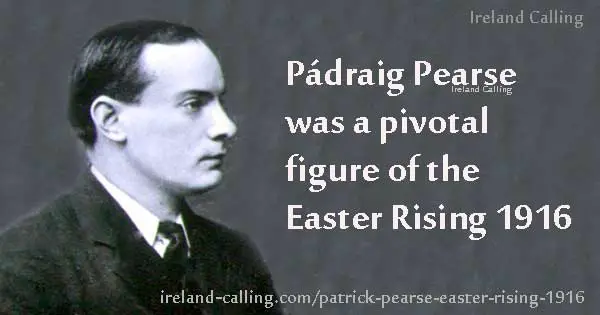
Pearse was devoted to Irish culture and is also referred to by the Irish versions of his name, Pádraic or Pádraig. He was a teacher, scholar and poet and is often described as a romantic, an idealistic visionary who dreamt of an independent Ireland that would regain its cultural heritage. He didn’t smoke or drink. He and his younger brother Willie swore an oath that they would free Ireland or die in the attempt.
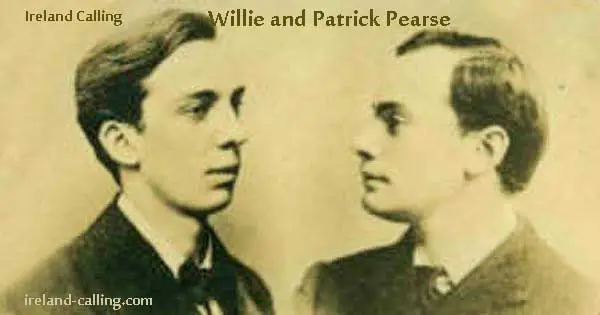
Patrick Pearse was born in Dublin on 10 November 1879. His father was English and his mother was from Co Meath. He was educated by the Christian Brothers and went on to gain a degree in Arts and Law at the Royal University. He qualified as a barrister in 1901.
He supported moves to revive the Irish language and culture and joined the Gaelic League. He went on to edit its paper, An Claidheamh Soluis (Sword of Light). He also set up St Enda’s School at Rathfarnham in Co Galway, where lessons were given in the Irish language and the emphasis was on nationalism and Ireland’s cultural heritage. Pupils were encouraged to “work hard for their fatherland, and if it should ever be necessary, die for it”.
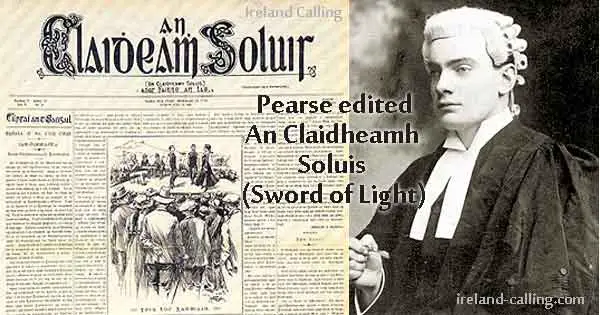
Belief in ‘blood sacrifice’ to create an independent Ireland
At first, Pearse supported the Home Rule movement, which sought partial self-government through an Irish parliament rather than full independence from Britain. His views soon hardened and he began to believe that Irish self-determination could only be achieved by revolution and “blood sacrifice”.
He joined the Irish Republican Brotherhood (IRB) in 1912 and soon became one of its leading figures. A year later, he became one of the founding members of the Irish Volunteers, formed by Eoin MacNeill.
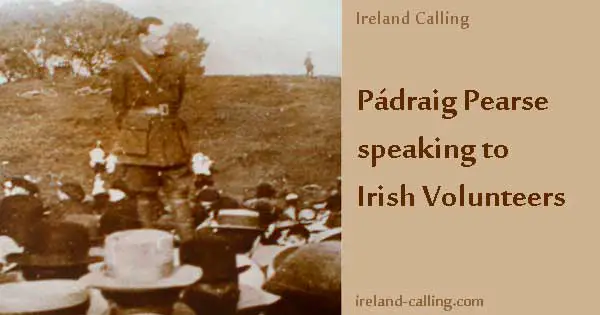
His reputation rose enormously when he gave one of the most important speeches in Irish history at the funeral of one of the founders of the IRB, Jeremiah O’Donovan Rossa, in 1915.
In the funeral oration, Pearse described how Britain thought it had subdued Ireland but was mistaken. He then finished with some famous words that some describe as the opening shots of the Easter Rising.

Referring to how the British thought they had subdued Ireland he said: “They think that they have pacified Ireland. They think that they have purchased half of us and intimidated the other half. They think that they have foreseen everything, think that they have provided against everything; but the fools, the fools, the fools! – they have left us our Fenian dead, and while Ireland holds these graves, Ireland unfree shall never be at peace.” A few months later, he gave another powerful speech at the commemoration of the death of Wolfe Tone.
Pearse was a member of the IRB military council that planned the Easter Rising. The others were Tom Clarke, James Connolly, Sean MacDiarmada, Joseph Plunkett and Thomas MacDonagh.
Fears that James Connolly was planning a rebellion
Pearse threw himself fully into the mission. He helped to arrange for German guns to be landed at Howth to arm the Irish Volunteers, who would provide most of the soldiers in the Rising. In January 1916, he came concerned that James Connolly was planning his own rebellion with the Irish Citizen Army, which had been formed as part of the Transport and General Workers’ Union.
He entered into three days of negotiations with Connolly who agreed to take part in a joint venture that was to become the Easter Rising. Pearse had to keep the agreement a secret from the Chief of Staff of the Volunteers, Eoin MacNeill, who was suspicious of Connolly. This was to backfire on Pearse for when MacNeill found out about the deception on the eve of Rising, he sent out an order to the Volunteers that the action had been cancelled.
Pearse and the Military Council decided to go ahead anyway in the hope that once the rebellion had started, the Volunteers would soon join in as originally planned. In the confusion caused by contradictory commands, that never happened and so the number of soldiers involved was much smaller than intended.
Reading the Proclamation of the Irish Republic
On 23 April, the day before the Easter Rising, the Military Council elected Pearse as Commandant-General of the Army of the Irish Republic and President of the Provisional Government. He was also chosen to read the Proclamation of the Republic the following day on the steps of the General Post Office (GPO).
The rebels soon took over the GPO and made it their headquarters. Although Pearse was the Commander General of the Rising, he left day to day military decisions of James Connolly, who was the commander of the Dublin forces. As nearly all the action took place in Dublin that meant Connolly was effectively in control of the whole armed effort.
Pearse remained in the GPO during the Easter Rising. He was the last to leave on 28 April as the burning building came under fire from British artillery. He and the few remaining volunteers moved the short distance to the top of Coogan’s grocery shop on the corner of Henry Street and Moore Street. Nearby buildings centred on 16 Moore Street became the final HQ of the Provisional Government.
As the rebels planned their next move, Pearse saw the nearby Flag pub had caught fire. The owner Robert Dillon, his wife and daughter came to escape the flames waving a white flag. They were immediately shot dead by British machine gun fire.
Their deaths affected Pearse deeply. He did not want to see the Rising lead to any more bloodshed, either among the rebels or innocent civilians. He made the decision to end the action to prevent further bloodshed.
Pearse’s note explaining decision to surrender
A nurse called Elizabeth O’Farrell was sent to let the British command know that the rebels were prepared to lay down their arms. Pearse surrendered to General Lowe on 29 April. He was then taken to Richmond Barracks, where General Maxwell made him sign several surrender notes.
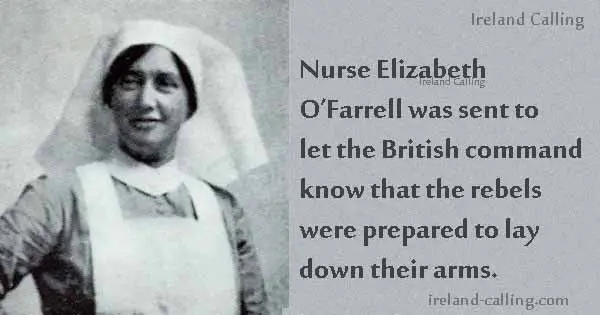
The text read:
In order to prevent further slaughter of Dublin citizens, and in the hope of saving the lives of our followers now surrounded and hopelessly outnumbered, the members of the Provisional Government present at Headquarters have agreed to an unconditional surrender, and the Commandants of the various districts in the City and the Country will order their commands to lay down arms.
PH Pearse, 29 April 1916, 3.45pm
Pearse was tried for treason at Richmond on 2 May. He fully admitted his role in the Rising, and may have even exaggerated it in an effort to take the blame and deflect it from others. He pleaded that he alone should be executed and the other rebels should be spared. He was found guilty in what was a foregone conclusion because General Maxwell, who was in charge of the operation to end the Rising, was determined that the leaders should be executed to deter further rebellions.

This is the death I would have asked for – Pearse
While in jail, knowing that he was to be executed, Pearse wrote to his mother saying: “This is the death I should have asked for if God had given me the choice of all deaths.”
Pearse was the first leader to be executed when he faced a firing squad at Kilmainham Gaol on 3 May 1916. He was buried at Arbour Hill Barracks together with two of his co-signatories of the Proclamation, Tom Clarke and Thomas MacDonagh, who had been executed that same day. Their bodies were thrown into a pit without coffins or a proper burial service.

It’s unlikely that Pearse ever thought that the rebels would win and the Rising would succeed. He believed that independence could not come through negotiations with the British, and that a “blood sacrifice” would be needed, if only to inspire the Irish people to demand their right to self-determination.
It was as if he anticipated failure even before the Rising was over when he wrote: “When we are all wiped out, people will blame us… In a few years they will see the meaning of what we tried to do.”
Those words turned out to be prophetic, for the people of Ireland were angry with the rebels at first and blamed them for the deaths of civilians during the Rising and the huge damage to iconic buildings in Dublin. Many also despised them for undermining the war effort when more than 200,000 Irish soldiers were fighting on Britain’s side.
Redmond wrongfully claimed Germany was behind Rising
John Redmond, leader of the Irish Parliamentary Party, fuelled that anger when he suggested that the rebellion had been sponsored by Germany. He wrote: “Germany plotted it, Germany organised it and Germany paid for it.”
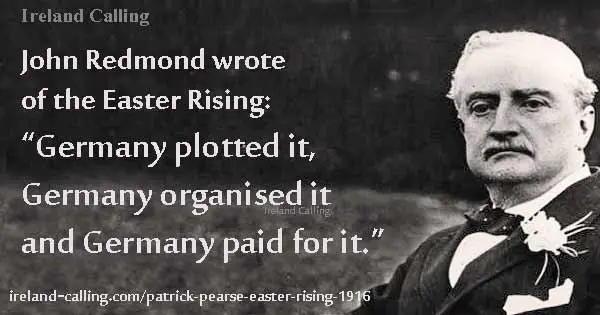
Redmond was completely wrong, as people began to realise when the writings of Pearse and the other leaders began to be published. It became apparent that, whether they were right or wrong in what they did, they acted only out of principle and a desire to achieve Irish independence.
As Pearse had anticipated, public opinion changed completely and the rebels came to be seen as true Irish patriots. The executions of the leaders like Pearse also led to an outcry as the public felt that the British were over-reacting and being unnecessarily harsh.
Within a few years, Redmond’s Parliamentary Party was swept away as the Sinn Fein nationalist party won a landslide victory in the 1918 General Election. Within a year, the Irish War of Independence was under way.
Pearse and the rebels may have got their way in the end.
Great Brunswick Street in Dublin where Pearse was born has been renamed Pearse Street in his honour. His St Enda’s School at Rathfarnham is now the Pearse Museum.
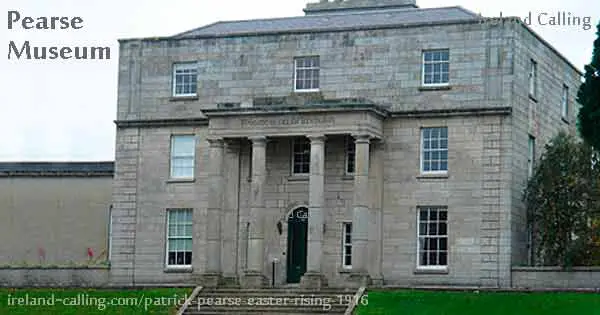
There are Pearse streets, Pearse roads and Pearse parks in towns all over Ireland. Dozens of Gaelic Athletic Association clubs in Ireland and across the world have also been named after him.
easter-rising-signatories.html